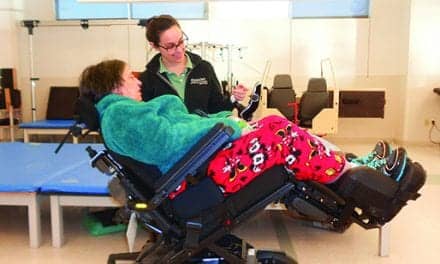It is not uncommon for musicians to have to work around scheduling conflicts, but Eddie Cleland, drummer for Los Angeles-based “Loose Chains” and two other bands, had to adjust his calendar to accommodate brain tumor surgery, which was performed by Keith Black, MD, chairman of the Department of Neurosurgery at Cedars-Sinai Medical Center, Los Angeles.
On Thanksgiving Day 2007, Cleland thought he might be having a stroke as he stepped out of bed because the left side of his body was extremely weak, so his wife Stephanie, called 911, Cedars says. Even though Cleland was feeling better by the time paramedics arrived, they took him to the nearest hospital for evaluation. The emergency room physician first suspected he was having a panic attack, but Cleland, a self-described “pretty mellow guy,” didn’t think so, and when his hand started to twitch during the evaluation, a CT scan was ordered. It showed a mass deep within Cleland’s brain, says Cedars.
The neurosurgeon who evaluated Cleland told him that although the tumor was causing mild seizures, it was not immediately life threatening, Cedars says. Cleland was released from the local hospital with anti-seizure medication and instructions to follow up with a brain tumor specialty center, which he did on December 3, 2007, says Cedars. A surgery date was set.
Cleland’s tumor was a diffuse astrocytoma, also called a Grade II glioma, says Cedars. Gliomas arise from glial cells, which provide support for nerve cells in the brain, and low-grade gliomas (Grade I and II) are considered premalignant, says Cedars. Although not yet cancers, 70% to 80% will increase in grade to become cancers over time, says Cedars.
Black said the treatment of choice is trying to remove all of the tumor, if possible, says Cedars, while noting that complete resection is not
curative because microscopic cells can hide in some areas and they can re-grow. The surgical team used imaging and electrical stimulation techniques to map out Cleland’s tumor, which was deep, and protect eloquent areas of his brain, says Cedars.
The operation was made more challenging by the fact that the tumor extended into the premotor area of Cleland’s brain, says Cedars. While the motor area is responsible for sending nerve impulses to the muscles to make them move, the premotor area is where the thought originates to initiate movement. Activation of the premotor area results in activation of the motor area.
Black notes that if a tumor is removed from the premotor area, about 80% of patients wake up with some significant weakness—but about 90% of them can completely recover because the areac an be reprogrammed and retrained very quickly, says Cedars.
Cleland opted for aggressive removal and experienced initial weakness, Cedars says. He underwent inpatient physical therapy and rehabilitation at Cedars-Sinai until January 11, 2008 before transitioning to outpatient rehabilitation at a hospital closer to his Sunland home.
By mid-April, the members of the band decided it was time for him to go back to work, which turned out to be an important part of his therapy, says Cedars, which reported the following: “The first rehearsal was brutal. It was horrible— like a 5-year-old,” said Cleland, who just celebrated his 46th birthday. “The funny thing was, the next day, when I went back to therapy, my brain was working 10 times better. Answers to problems were coming quicker and I was doing better on the tests.” With each rehearsal, he improved dramatically. “I had my physical therapy, my speech therapy, and my music therapy,” he said.
Cleland will share his experiences at a free community conference for patients, families, and caregivers on June 13 at Cedars. Physicians, neurosurgeons, research scientists, and other brain tumor survivors will participate in the program, scheduled from 7:45 am to 4:30 pm. Information will be provided on treatment options, new research findings, and experimental therapies. To register, visit www.cedars-sinai.edu/braintumor.
[Source: [removed]Cedars Sinai[/removed]]




